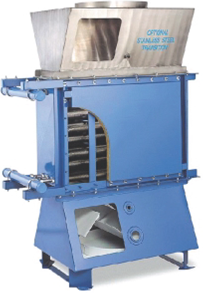Heat Recovery with Boiler Stack Economizers
Heat Recovery with Boiler Stack Economizers
Please note: This publication may refer to programs that are no longer available. For current information, please visit ecoENERGY or contact us.
Description

Figure 1 - Stack Economizer
A stack economizer (Figure 1) is a water-to-air heat exchanger that is designed to use heat from hot boiler flue gases to preheat water. For many decades, economizers have been used on large utility steam boilers to preheat the feedwater using recovered stack heat. The same principle can be applied to smaller hydronic heating boilers where there is a nearby demand for hot water. These installations have become more economical as energy prices have risen and smaller economizers with light but durable and efficient heat exchangers have been developed.
Technical Specifications
Economizers are sized to be installed into the stack, as close to the boiler's flue outlet as practical. Figure 2 shows a schematic of a stack economizer used to recover heat from a boiler stack to heat domestic hot water for a building.
The interior of the stack economizer must be able to withstand the corrosive effects of condensing flue gases. Heat is typically exchanged through finned tubes that must be constructed from a high-grade stainless steel. The inside surface must be accessible for inspection and cleaning.
This type of economizer is typically feasible for boilers of at least 590 kW (60 hp) and where at least 60 percent of the recoverable waste stack heat can be used to preheat cold water. The boiler must also have a forced-draft burner and must not be the high-efficiency condensing type.
Energy Information
The real energy savings from a boiler stack economizer come from the drop in temperature of the flue gases flowing through the economizer, multiplied by the mass flow rate of the flue gases. A typical non-condensing boiler has a flue gas temperature of 135°C (275°F). A properly sized economizer will drop the flue gas temperature to 77°C (170°F), condensing the flue gases and transferring absorbed heat into the water flow. The economizer can raise the effective seasonal thermal efficiency of these boilers from below 80 percent to nearly 90 percent.

Figure 2 – Sample of a schematic drawing of Stack Economizer Installation
[Text Version - Figure 2]
Comparison
In terms of energy performance, an existing boiler system with an added stack economizer becomes, in essence, a condensing boiler (Figure 3). One advantage of the stack economizer/boiler combination over a new condensing boiler is that with the economizer, flue gases condense at more typical return water temperatures of 70°C (160°F). A condensing boiler typically needs return water temperatures below 60°C (140°F) in order to condense. However, condensing boilers can operate at much higher efficiencies under proper design conditions.

Figure 3 – Stack Economizer Installed on a Boiler Vent
Case Study
At the Vancouver Aquatic Centre in British Columbia, a Cannon FS-5-DS5 stack economizer has been installed to preheat cold make-up water for the pool. The unit was designed to recover a constant 66 kW (225 000 Btu/h) from the flue gases of either of the two 980-kW (3.35 MMBtu/hr1) Cleaver Brooks CB fire-tube boilers.
As shown in Table 1, this system saves approximately 900 gigajoules per year, which is currently worth $8,100 per year at local commercial rates. A system installed today would have a good simple payback period of 3.45 years. This system has been operating successfully for five years with no problems. The finned tubes in the economizer have not yet needed cleaning.
1MMBtu/hr = millions of Btu per hour; MBtu/hr = thousands of Btu per hour.
| Input Data | |
|---|---|
| Natural Gas Rate | $9.00/ GJ |
| Boiler Input Capacity (2 boilers) | 7.6 MMBtu/hr |
| Heat Recovery Capacity (2 boilers) | 450 MBtu/hr |
| Operating Hours | 4200 hours |
| Payback Summary | |
| Annual Natural Gas Savings | 900 GJ/yr |
| Net Annual Cost Savings | $8,100 |
| Construction Cost | $28,000 |
| Payback Period (years) | 3.45 yrs |
You can find other buildings publications from the Office of Energy Efficiency. To order paper copies, or to discuss how we can help you make your property more energy efficient, please contact us.
Buildings Division
Office of Energy Efficiency
Natural Resources Canada
580 Booth Street, 18th floor
Ottawa ON K1A 0E4
Tel.: 877-360-5500 (toll free)
Fax: 613-947-4121
Web site: http://www.nrcan.gc.ca/energy/efficiency/eefb/buildings/13556
Page details
- Date modified: